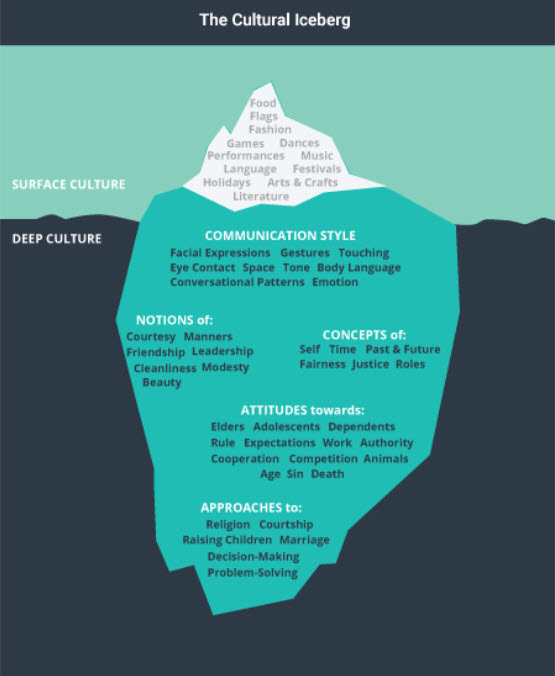1.4 Intercultural Communication
It is not possible to discuss good communication skills in business without discussing intercultural communication. We may be tempted to think of intercultural communication as interaction between two people from different countries. While two distinct national passports communicate a key part of our identity non-verbally, what happens when two people from two different parts of the same country communicate? Indeed, intercultural communication happens between subgroups of the same country. Whether it be the distinctions between dialects in the same language, the differences in perspective between people living in different parts of the country, or the rural- versus-urban dynamic, our geographic, linguistic, educational, sociological, and psychological traits influence our communication.
Culture is part of the very fabric of our thought, and we cannot separate ourselves from it, even as we leave home and begin to define ourselves in new ways through work and achievements. Every business or organization has a culture, and within what may be considered a global culture, there are many subcultures or co-cultures. For example, consider the difference between the sales and accounting departments in a corporation. We can quickly see two distinct groups with their own symbols, vocabulary, and values. Within each group there may also be smaller groups, and each member of each department comes from a distinct background that in itself influences behaviour and interaction.
Suppose we have a group of students who are all similar in age and educational level. Do gender and the societal expectations of roles influence interaction? Of course! There will be differences on multiple levels.
More than just the clothes we wear, the movies we watch, or the video games we play, all representations of our environment are part of our culture. Culture also involves the psychological aspects and behaviours that are expected of members of our group. From the choice of words (message), to how we communicate (in person or by e-mail), to how we acknowledge understanding with a nod or a glance (non-verbal feedback), to the internal and external interference, all aspects of communication are influenced by culture.
Defining culture
Culture consists of the shared beliefs, values, and assumptions of a group of people who learn from one another and teach to others that their behaviours, attitudes, and perspectives are the correct ways to think, act, and feel.
It is helpful to think about culture in the following five ways:
- Culture is learned.
- Culture is shared.
- Culture is dynamic.
- Culture is systemic.
- Culture is symbolic.
The iceberg, shown in Figure 1.2. , is a commonly used metaphor to describe culture and is great for illustrating the tangible and the intangible. When talking about culture, most people focus on the “tip of the iceberg,” which is visible but makes up just 10 percent of the object. The rest of the iceberg, 90 percent of it, is below the waterline.

Figure 1.2 | The cultural iceberg (by Laura Underwood), adapted from Lindner (2013)
Many business leaders, when addressing intercultural situations, pick up on the things they can see—things on the “tip of the iceberg.” Things like food, clothing, and language difference are easily and immediately obvious, but focusing only on these can mean missing or overlooking deeper cultural aspects such as thought patterns, values, and beliefs that are under the surface. Solutions to any interpersonal miscommunication that results become temporary bandages covering deeply rooted conflicts.
Multicultural, cross-cultural, and intercultural communication
Although they are often used interchangeably, it is important to note the distinctions between the terms multicultural, cross-cultural, and intercultural communication.
Multiculturalism is a rather surface approach to the coexistence and tolerance of different cultures. It takes the perspective of “us and the others” and typically focuses on those tip-of-the-iceberg features of culture, thus highlighting and accepting some differences but maintaining a “safe” distance. If you have a multicultural day at work, for example, it usually will feature some food, dance, dress, or maybe learning about how to say a few words or greetings in a sampling of cultures.
Cross-cultural approaches typically go a bit deeper, the goal being to be more diplomatic or sensitive. They account for some interaction and recognition of difference through trade and cooperation, which builds some limited understanding—such as, for instance, bowing instead of shaking hands, or giving small but meaningful gifts. A common drawback of cross-cultural comparisons is that we can wade into stereotyping and ethnocentric attitudes—judging other cultures by our own cultural standards—if we aren’t mindful.
Lastly, when we look at intercultural approaches, we are well beneath the surface of the iceberg, intentionally making efforts to better understand other cultures as well as ourselves. An intercultural approach is not easy and is often messy, but when you get it right, it is usually far more rewarding than the other two approaches. The intercultural approach is difficult and effective for the same reasons; it acknowledges complexity and aims to work through it to a positive, inclusive, and equitable outcome.
Whenever we encounter someone, we notice similarities and differences. While both are important, it is often the differences that contribute to communication troubles. We don’t see similarities and differences only on an individual level. In fact, we also place people into in-groups and out-groups based on the similarities and differences we perceive. We tend to react to someone we perceive as a member of an out-group based on the characteristics we attach to the group rather than the individual (Allen, 2010). In these situations, it is more likely that stereotypes and prejudice will influence our communication. This division of people into opposing groups has been the source of great conflict around the world, and learning about difference and why it matters will help us be more competent communicators and help to prevent conflict.

